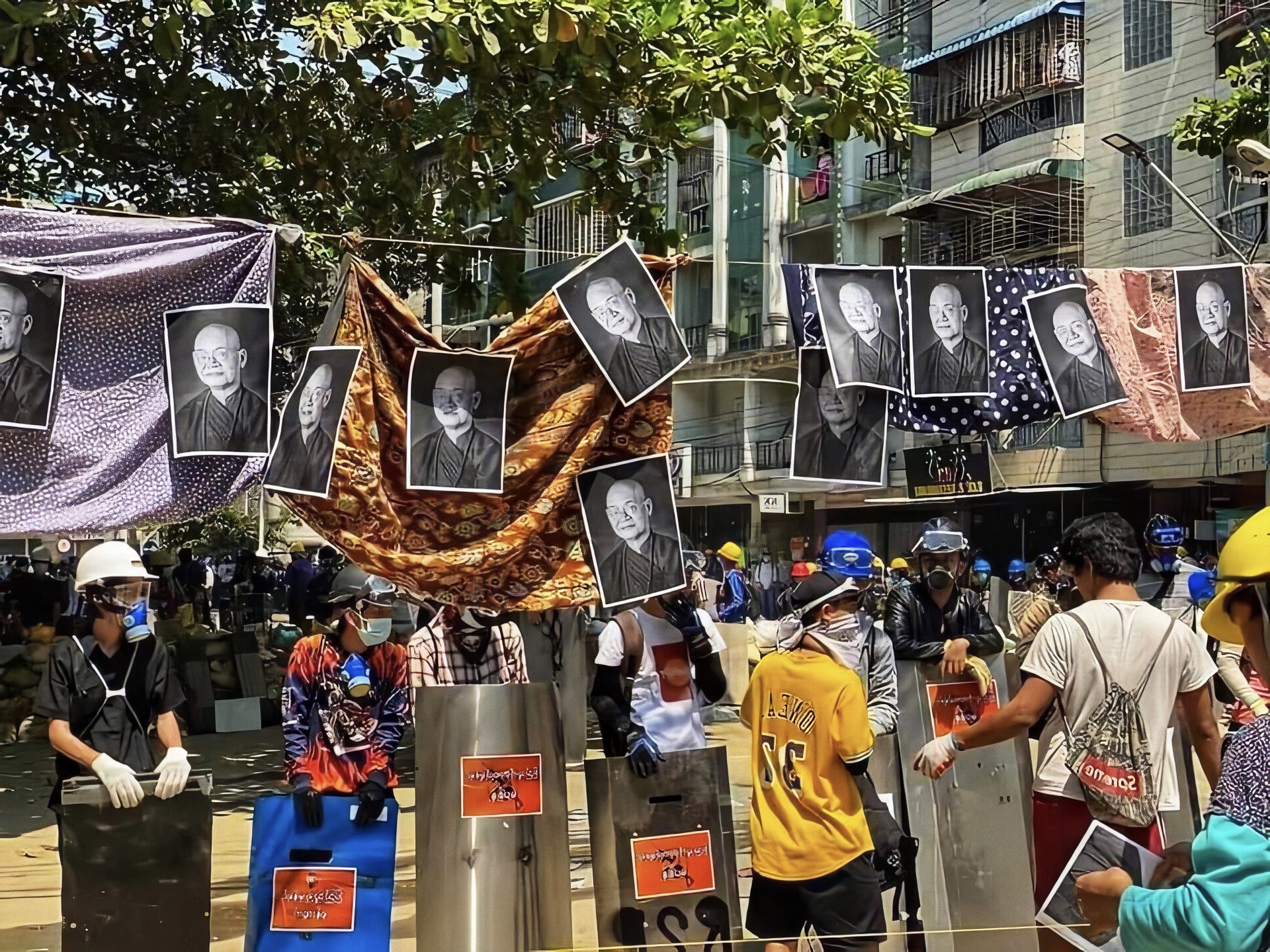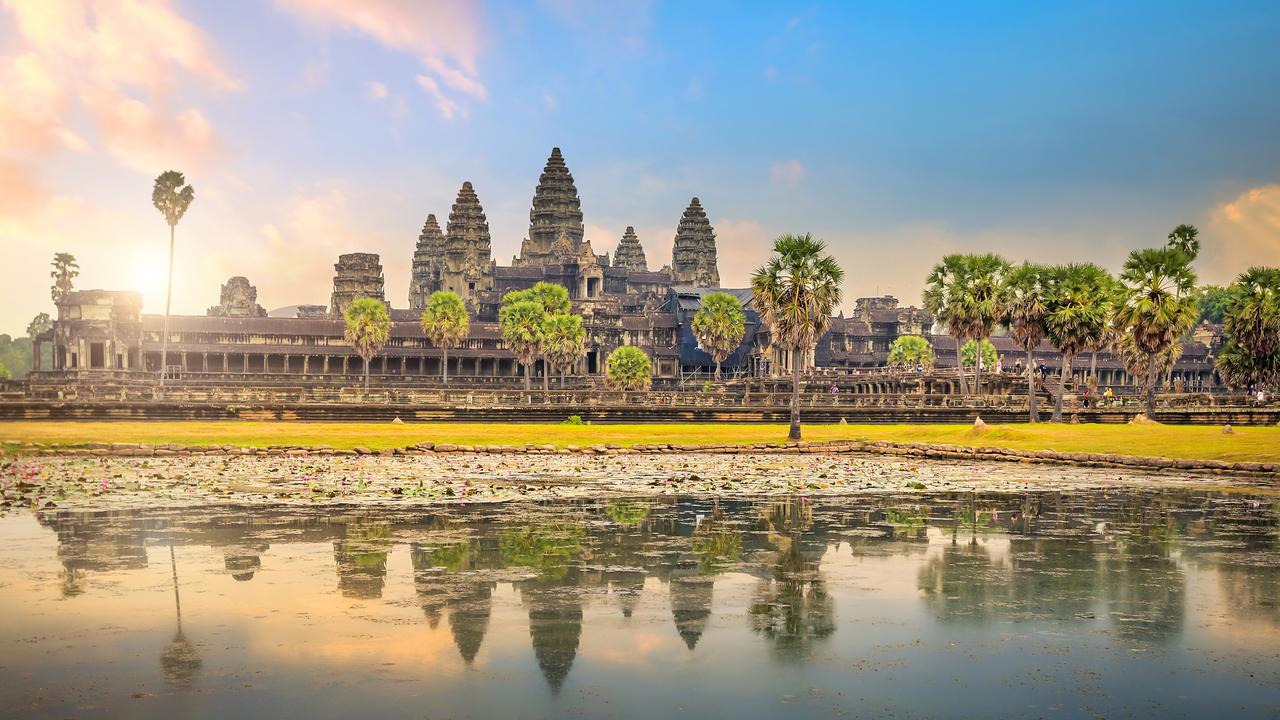|
Vasipake Sayadaw
Bhaddanta Vimala Ashin Kovida (; born 14 May 1957), best known as Vasipake Sayadaw (), is a Burmese Buddhist monk, astrologer and occult practitioner. He is believed to be the Senior General Min Aung Hlaing's chief astrological adviser. He is famous for his vow of silence. Vasipake played a major role in the 2021 Myanmar coup d'état. Life His origin is very unclear. Sayadaw is the abbot of Thiladhamma Gonethar Tawya Monastery in Keng Tung. Senior General Min Aung Hlaing has been his follower since 2006, when he was serving as the commander of the Myanmar military's Triangle Region, which oversees eastern Shan State. Some people believed that he is to be Min Aung Hlaing's spiritual cover. He has ties with Sitagu Sayadaw. In February 2020, Sayadaw was with Min Aung Hlaing and his wife Kyu Kyu Hla when they placed the "Hti" umbrella on top Bagan's most powerful ancient Htilominlo Temple. The meaning of the temple name is "need the royal umbrella, need the King". He was following ... [...More Info...] [...Related Items...] OR: [Wikipedia] [Google] [Baidu] |
Burmese Buddhist Titles
Burmese Buddhist titles () encompass numerous honorific titles conferred by the Burmese government, to recognize members of the Sangha as well as civilians. These religious titles are conferred annually by the Burmese government, in a special ceremony during the full moon day of Tabaung, at the Uppatasanti Pagoda in Naypyidaw. From 1988 to 2008, the ceremony was held at the Mahāpāsaṇa Cave, near Kaba Aye Pagoda in Yangon. History In the pre-colonial era, the Burmese monarchy recognized Buddhist monks and laypersons by bestowing religious titles composed of Pali and native Burmese styles. Sayadaw (ဆရာတော်), which literally means "teacher of royalty," was originally bestowed to monks who had educated the king as monastic teachers or tutors, although its usage grew more commonplace with time. Pagan era During the Pagan Kingdom, several kings awarded religious titles to prominent Buddhist monks. Pinya and Innwa eras Konbaung era During the Konbaung ... [...More Info...] [...Related Items...] OR: [Wikipedia] [Google] [Baidu] |
Temple
A temple (from the Latin ) is a place of worship, a building used for spiritual rituals and activities such as prayer and sacrifice. By convention, the specially built places of worship of some religions are commonly called "temples" in English, while those of other religions are not, even though they fulfill very similar functions. The religions for which the terms are used include the great majority of ancient religions that are now extinct, such as the Ancient Egyptian religion and the Ancient Greek religion. Among religions still active: Hinduism (whose temples are called Mandir or Kovil), Buddhism (whose temples are called Vihar), Sikhism (whose temples are called gurudwara), Jainism (whose temples are sometimes called derasar), Zoroastrianism (whose temples are sometimes called Agiary), the Baháʼí Faith (which are often simply referred to as Baháʼí House of Worship), Taoism (which are sometimes called Daoguan), Shinto (which are often called Jinja), C ... [...More Info...] [...Related Items...] OR: [Wikipedia] [Google] [Baidu] |
Burmese Theravada Buddhists
Burmese may refer to: * Something of, from, or related to Myanmar, a country in Southeast Asia * Burmese people * Burmese language * Burmese alphabet * Burmese cuisine * Burmese culture Animals * Burmese cat * Burmese chicken * Burmese (horse), a horse given to Queen Elizabeth II * Burmese pony, a breed of horse * Burmese python See also * * :Burmese people * Bamar people The Bamar people ( Burmese: ဗမာလူမျိုး, ''ba. ma lu myui:'' ) (formerly known as Burmese people or Burmans) are a Sino-Tibetan-speaking ethnic group native to Myanmar (formerly known as Burma). With an estimated population ..., the majority ethnic group in Myanmar * Burmese English, the dialect of English spoken in Myanmar/Burma * Bernese (other) {{disambig Language and nationality disambiguation pages ... [...More Info...] [...Related Items...] OR: [Wikipedia] [Google] [Baidu] |
Theravada Buddhist Monks
''Theravāda'' (; 'School of the Elders'; ) is Buddhism's oldest existing school. The school's adherents, termed ''Theravādins'' (anglicized from Pali ''theravādī''), have preserved their version of the Buddha's teaching or ''Dharma (Buddhism), Dhamma'' in the Pāli Canon for over two millennia. The Pāli Canon is the most complete Buddhist canon surviving in a Indo-Aryan languages, classical Indian language, Pāli, which serves as the school's sacred language and ''lingua franca''.Crosby, Kate (2013), ''Theravada Buddhism: Continuity, Diversity, and Identity'', p. 2. In contrast to Mahāyāna and Vajrayāna, Theravāda tends to be conservative in matters of doctrine (''pariyatti'') and monastic discipline (''vinaya''). One element of this Religious conservatism, conservatism is the fact that Theravāda rejects the authenticity of the Mahayana sutras (which appeared onwards). Consequently, Theravāda generally does not recognize the existence of many Buddhas and bodhisattva ... [...More Info...] [...Related Items...] OR: [Wikipedia] [Google] [Baidu] |
Living People
Purpose: Because living persons may suffer personal harm from inappropriate information, we should watch their articles carefully. By adding an article to this category, it marks them with a notice about sources whenever someone tries to edit them, to remind them of WP:BLP (biographies of living persons) policy that these articles must maintain a neutral point of view, maintain factual accuracy, and be properly sourced. Recent changes to these articles are listed on Special:RecentChangesLinked/Living people. Organization: This category should not be sub-categorized. Entries are generally sorted by family name In many societies, a surname, family name, or last name is the mostly hereditary portion of one's personal name that indicates one's family. It is typically combined with a given name to form the full name of a person, although several give .... Maintenance: Individuals of advanced age (over 90), for whom there has been no new documentation in the last ten ... [...More Info...] [...Related Items...] OR: [Wikipedia] [Google] [Baidu] |
Monk
A monk (; from , ''monachos'', "single, solitary" via Latin ) is a man who is a member of a religious order and lives in a monastery. A monk usually lives his life in prayer and contemplation. The concept is ancient and can be seen in many religions and in philosophy across numerous cultures. The Greek word for "monk" may be applied to men or women. In English, however, "monk" is applied mainly to men, while ''nun'' is typically used for female monastics. Although the term ''monachos'' is of Christianity, Christian origin, in the English language ''monk'' tends to be used loosely also for both male and female ascetics from other religious or philosophical backgrounds. However, being generic, it is not interchangeable with terms that denote particular kinds of monk, such as cenobite, hermit, anchorite, or Hesychasm, hesychast. Traditions of Christian monasticism exist in major Christian denominations, with religious orders being present in Catholicism, Lutheranism, Oriental Ort ... [...More Info...] [...Related Items...] OR: [Wikipedia] [Google] [Baidu] |
Htamein
A longyi (; ) is a sheet of cloth widely worn in Myanmar (Burma). It is approximately long and wide. The cloth is often sewn into a cylindrical shape. It is worn around the waist, running to the feet, and held in place by folding fabric over without a knot. In ancient times, lethwei fighters would hitch it up (paso hkadaung kyaik) to compete. This folding technique is still being used in modern days when people play chinlone. History The modern ''longyi'', a single piece of cylindrical cloth, is a relatively recent introduction to Burma. It gained popularity during British colonial rule, effectively replacing the ''paso'' and ''htamein'' of precolonial times. The word ''longyi'' formerly referred to the sarong worn by Malay men. In the precolonial era, men's pasos used to be a long piece of called ''taungshay paso'' () and unsewn. Alternately the ''htamein'' was a long piece of cloth open at the front to reveal the calves, with a dark strip of cotton or velvet sewn on the ... [...More Info...] [...Related Items...] OR: [Wikipedia] [Google] [Baidu] |
2021 Myanmar Protests
1 (one, unit, unity) is a number, numeral, and glyph. It is the first and smallest positive integer of the infinite sequence of natural numbers. This fundamental property has led to its unique uses in other fields, ranging from science to sports, where it commonly denotes the first, leading, or top thing in a group. 1 is the unit of counting or measurement, a determiner for singular nouns, and a gender-neutral pronoun. Historically, the representation of 1 evolved from ancient Sumerian and Babylonian symbols to the modern Arabic numeral. In mathematics, 1 is the multiplicative identity, meaning that any number multiplied by 1 equals the same number. 1 is by convention not considered a prime number. In digital technology, 1 represents the "on" state in binary code, the foundation of computing. Philosophically, 1 symbolizes the ultimate reality or source of existence in various traditions. In mathematics The number 1 is the first natural number after 0. Each natural numb ... [...More Info...] [...Related Items...] OR: [Wikipedia] [Google] [Baidu] |
Vasipake Sayadaw
Bhaddanta Vimala Ashin Kovida (; born 14 May 1957), best known as Vasipake Sayadaw (), is a Burmese Buddhist monk, astrologer and occult practitioner. He is believed to be the Senior General Min Aung Hlaing's chief astrological adviser. He is famous for his vow of silence. Vasipake played a major role in the 2021 Myanmar coup d'état. Life His origin is very unclear. Sayadaw is the abbot of Thiladhamma Gonethar Tawya Monastery in Keng Tung. Senior General Min Aung Hlaing has been his follower since 2006, when he was serving as the commander of the Myanmar military's Triangle Region, which oversees eastern Shan State. Some people believed that he is to be Min Aung Hlaing's spiritual cover. He has ties with Sitagu Sayadaw. In February 2020, Sayadaw was with Min Aung Hlaing and his wife Kyu Kyu Hla when they placed the "Hti" umbrella on top Bagan's most powerful ancient Htilominlo Temple. The meaning of the temple name is "need the royal umbrella, need the King". He was following ... [...More Info...] [...Related Items...] OR: [Wikipedia] [Google] [Baidu] |
Astrology
Astrology is a range of Divination, divinatory practices, recognized as pseudoscientific since the 18th century, that propose that information about human affairs and terrestrial events may be discerned by studying the apparent positions of Celestial objects in astrology, celestial objects. Different cultures have employed forms of astrology since at least the 2nd millennium BCE, these practices having originated in Calendrical calculation, calendrical systems used to predict seasonal shifts and to interpret celestial cycles as signs of divine communications. Most, if not all, cultures have attached importance to what they observed in the sky, and some—such as the Hindu astrology, Hindus, Chinese astrology, Chinese, and the Maya civilization, Maya—developed elaborate systems for predicting terrestrial events from celestial observations. Western astrology, one of the oldest astrological systems still in use, can trace its roots to 19th–17th century BCE Mesopotamia, fr ... [...More Info...] [...Related Items...] OR: [Wikipedia] [Google] [Baidu] |
Yadaya
Yadaya (, ; from Sanskrit ; variously spelt yadayar and yedaya) refers to Superstition, superstitious Magic (supernatural), magical rituals done to delay, neutralize or prevent misfortune, widely practiced in Myanmar (Burma). These rituals, which originate from Vedic Brahmanism, Brahmanism, are guided and prescribed by soothsayers and astrologers, who use a combination of mathematical equations and astrology to formulate a "prescription" to avert misfortune. Modern Burmese leaders, including U Nu, Ne Win, Than Shwe, Min Aung Hlaing, and many government policy decisions are widely understood to have been influenced by yadaya rituals. Among Buddhism in Burma, Burmese Buddhists, yadaya is often linked to merit-making, as some prescriptive rituals involve seemingly "Buddhist" acts, although they are done to bypass karma, karmic fate, which cannot be altered by ritual in Buddhist doctrine. Yadaya is closely associated to numerology, particularly the number nine, which is widely believed ... [...More Info...] [...Related Items...] OR: [Wikipedia] [Google] [Baidu] |






